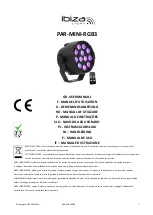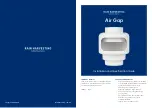
FMA SERIES
23
5.3.
ADJUSTMENTS
WARNING
All adjustment operations must be performed with the tractor engine off, the PTO disengaged, the
hoe lowered to the ground or on security stands, the parking brake set and the ignition key off.
FRICTION CLUTCH ADJUSTMENT
The PTO driveshaft and friction clutch are designed to transmit adequate power to the hoe.
The clutch preserves the machine from overloads, through the slipping of friction discs, and limits
the max torque transmissible to a calibrated value set at factory. It is recommended, therefore, to
leave unchanged this value to avoid damages to the machine or to driveshaft.
An adjustment can be done, however, when the clutch slipping is too frequent, which means that
the calibration is too low.
In this case, the tightening of nuts over the compressed springs will give an increase in torque
transmissible.
On the contrary, a loosening of the nuts over the springs will give a decrease in torque transmissible.
IMPORTANT
For details about clutch adjustment, refer to the user manual of the manufacturer of the driveshaft
installed.
The manufacturer is not liable for damages resulting from a wrong modification of the clutch
calibration.
NOTE
Excessive tightening of the springs can prevent the clutch from slipping and to protect the machine
from overload.
Make sure that the height of all the compressed springs is equal to prevent clutch malfunctioning.
SKIDS ADJUSTMENT
The working depth of the hoe is determined by the position of the side skids: it may be increased by
raising or lowering the skids. It's important that both skids are adjusted at the same height.
To adjust the working depth, perform the following steps:
•
lift the machine, put it safely on security stands, then switch the tractor engine off, disengage
PTO, set parking brake and off the ignition key;
Summary of Contents for ROTARY HOE FMA 105
Page 40: ...NOTES ...
Page 41: ...NOTES ...
















































